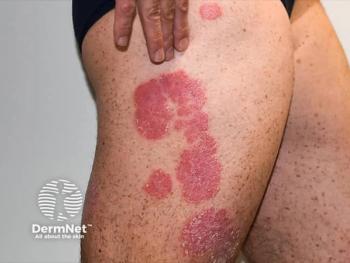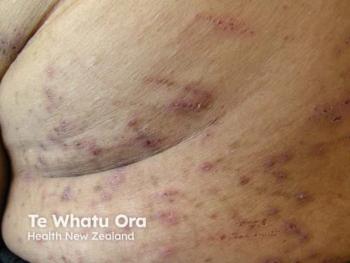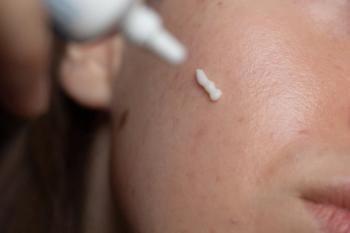
Guselkumab Effective in Real-World Korean Psoriasis Study
Key Takeaways
- Guselkumab demonstrated high effectiveness in real-world settings, with 96% of patients achieving a PASI ≤3 by week 44.
- Biologic-naïve patients showed greater clinical improvement compared to those previously treated with biologics, suggesting guselkumab's potential as a first-line therapy.
Guselkumab shows high effectiveness and safety in treating moderate to severe plaque psoriasis, enhancing quality of life in real-world Korean patients.
Guselkumab, a selective interleukin-23 (IL-23) p19 subunit inhibitor, has emerged as a cornerstone in the biologic treatment landscape for moderate to severe plaque psoriasis.1 While clinical trials have consistently shown guselkumab’s efficacy and safety, translating those results into real-world settings remains a key step in understanding its broader therapeutic value. A recent postmarketing surveillance study conducted across 44 clinical centers in South Korea offers robust real-world data on the performance of guselkumab in routine dermatologic practice.2
Methods
This prospective, non-interventional study included 707 adult patients diagnosed with moderate to severe plaque psoriasis, defined by a Psoriasis Area and Severity Index (PASI) score ≥10 or body surface area (BSA) involvement of ≥10%. The primary aim was to assess treatment effectiveness, safety, and drug survival over a 56-week period. Patients received guselkumab per the standard dosing schedule: 100 mg administered subcutaneously at weeks 0 and 4, followed by maintenance dosing every 8 weeks.
Results
The effectiveness analysis set comprised 531 patients who had both baseline and post-baseline assessments. By week 44 (visit 7), 96.0% of patients achieved a PASI ≤3, and 86.7% and 59.0% attained PASI ≤2 and ≤1, respectively. Meaningful improvements were also reflected in PASI75 (98.5%), PASI90 (74.3%), and PASI100 (25.4%) response rates. Investigator’s Global Assessment (IGA) scores further confirmed these findings, with 96.5% of patients reaching an IGA of 0 or 1, denoting clear or nearly clear skin.
The study found that biologic-naïve patients consistently demonstrated greater clinical improvement compared to those previously treated with biologics. At visit 7, PASI90 was achieved by 78.0% of biologic-naïve patients versus 59.0% of biologic-experienced patients. A similar trend was observed in PASI75 and PASI100 responses. These results suggest that prior biologic exposure may influence the depth of response to guselkumab, positioning it as a compelling option for first-line biologic therapy.
Quality of life, as measured by the Dermatology Life Quality Index (DLQI), improved substantially. The mean DLQI score declined to 2.0 ± 3.1 by the end of the study, with 64.1% of patients reporting DLQI scores of 0 or 1, indicating minimal impact of psoriasis on daily life. These improvements were comparable across both biologic-naïve and experienced cohorts.
Drug survival, a proxy for long-term tolerability and efficacy, was high, with a 1-year retention rate of 92.7%. Reasons for discontinuation were primarily unrelated to adverse drug reactions, including loss to follow-up and patient withdrawal. This strong adherence underscores guselkumab’s acceptability in real-world use.
Safety outcomes were favorable. Adverse events (AEs) were reported in 22.5% of patients, equating to an incidence rate of 42.1 per 100 patient-years. The most commonly reported AEs were pruritus, urticaria, and folliculitis. Serious AEs were rare (1.8% incidence), and no unexpected safety signals emerged. Importantly, the study reported only 2 malignancy cases and no instances of nonmelanoma skin cancer.
Multivariable analysis identified predictors of achieving a PASI90 response, including women, higher baseline PASI score, moderate baseline IGA, and absence of nail psoriasis. Concomitant topical therapy was associated with a lower likelihood of PASI90, potentially reflecting more refractory disease.
Conclusions
This study’s strengths lie in its large sample size, multicenter design, and real-world relevance. Although the absence of a control group and potential underreporting of rare AEs are limitations, the findings align closely with those observed in randomized controlled trials, reaffirming guselkumab’s role as an effective and well-tolerated treatment for moderate to severe plaque psoriasis.
The study found that guselkumab demonstrated high effectiveness, sustained quality of life improvements, strong treatment adherence, and a favorable safety profile in Korean patients with moderate to severe plaque psoriasis. These findings support its continued use across diverse clinical settings, particularly as a first-line biologic in biologic-naïve patients.
References
- Menter A, Strober BE, Kaplan DH, et al. Joint AAD-NPF guidelines of care for the management and treatment of psoriasis with biologics. J Am Acad Dermatol. 2019;80(4):1029-1072. doi:10.1016/j.jaad.2018.11.057
- Shin BS, Kim M, Suh MK, et al. Effectiveness and safety of guselkumab in patients with moderate-to-severe plaque psoriasis in real-world practice in Korea: A prospective, multicenter, observational, postmarketing surveillance study. J Dermatol. Published online April 28, 2025. doi:10.1111/1346-8138.17757
Newsletter
Like what you’re reading? Subscribe to Dermatology Times for weekly updates on therapies, innovations, and real-world practice tips.


















